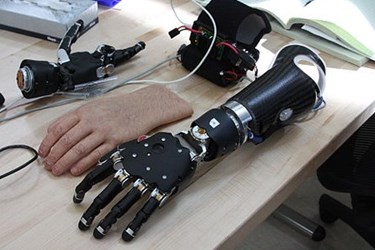How Do Prosthetic Miscues Impact Amputees?
By Chuck Seegert, Ph.D.

Electrical signals from a patient’s muscles are sometimes coded into signals that drive robotic prostheses. At times, mixed signals can lead to errant prosthetic reactions, causing falls. Recently, a group of researchers from North Carolina State University studied those mixed signals to improve the design of prosthetic control systems and prevent falls.
Robotic prosthetics are advancing rapidly in the medical device space and have markedly increased in complexity. Some designs use brainwaves to drive robotic actions, whereby the user’s thoughts are translated into action. Others use electrical impulses from an amputee’s stump to drive the robotics. Each system has strengths, and each has the potential to incorrectly interpret signals from the user such that the prosthesis performs an unanticipated action. If the prosthesis is weight-bearing, it is conceivable that the malfunction could cause a user to fall unexpectedly.
Studying this scenario was the goal of researchers from North Carolina State University (NC State), according to a recent press release from NC State News.
Control systems work to decode the signals from muscles and translate them into signals that power a limb. But, according to Fan Zhang, a Ph.D. student in the joint biomedical engineering program of North Carolina State University and the University of North Carolina at Chapel Hill, “sometimes this ‘decoding’ technology makes mistakes, such as thinking someone wants to climb a step when he doesn’t. This is a problem, because we don’t want to put users at risk of stumbling or falling.”
Prosthetic control systems must essentially recognize an amputee’s intent about how they wish to move, according to a recent study published by the team in IEEE Transactions on Neural Systems and Rehabilitation Engineering. Finding out what happens when the control system incorrectly interprets this intent was the goal of the team’s work. The importance of this question is highlighted by the fact that errors are inevitable in any system, and knowing how these errors affect a user will potentially allow the consequences to be minimized.
“Any system that involves a human interface will have occasional errors,” noted Dr. Helen Huang, senior author of the study and an associate professor in the joint biomedical engineering program, according to the press release. “But we think we can find ways to make those errors effectively insignificant.”
To shed light in this area, the team used prostheses that intentionally led to miscoding, so the critical errors that impact a users gait could be identified, according to the study.
The results of the study led to some interesting findings. Insignificant miscoding errors were usually short in nature and occurred when no weight was on the prosthesis. These errors were not noticeable by the users. More critical errors, or those that were especially noticeable by the user, were also evaluated. These critical errors were caused by “mechanical work change,” which meant that the prosthesis interpreted that it needed to do “significantly more or less work than the user intended,” according to the study.
The contrast between stable and unstable tests can be viewed in the following two videos:
Improving robotic prostheses is a major focus in the medical device research arena. Recently, a mind-controlled prosthesis that incorporated sensory feedback from the user was discussed in an article on Med Device Online.
Image Credit: Official Navy Page from United States of America Sarah Fortney/U.S. Navy (The Modular Prosthetic Limb (MPL).) [Public domain], via Wikimedia Commons
